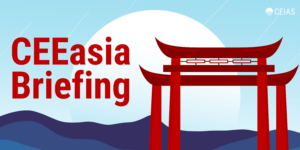As tensions rise across both the Taiwan Strait and the Korean Peninsula, the United States, Japan, and South Korea face an increasing risk of a two-front crisis—one that ominously recalls the strategic shock of 1979.
Key takeaways:
-
China’s escalating military pressure on Taiwan and North Korea’s advancing nuclear arsenal, compounded by deepening Russia–North Korea ties, make a dual contingency scenario increasingly plausible in East Asia.
-
As NATO did in response to the Soviet threat in 1979, the US–Japan–South Korea alliance must formalize joint contingency planning, establish integrated logistics frameworks, and conduct high-end trilateral exercises to enhance readiness and deterrence.
-
A dedicated trilateral offset strategy and the establishment of an Extended Deterrence Planning Group are essential to maintaining a technological edge and ensuring credible nuclear deterrence in the face of potential coordinated aggression.
The challenges now confronting the Indo-Pacific alliance are not theoretical; they are unfolding in real time. Beijing has intensified military coercion around Taiwan, simulating amphibious landings and rehearsing saturation missile strikes on US bases. Meanwhile, Pyongyang has declared itself a “responsible nuclear state,” unveiled tactical nuclear war plans, and entered into a mutual defense pact with Moscow. Though these developments are distinct, they increasingly suggest a convergence of threats across East Asia’s two most volatile flashpoints.
The US–Japan–South Korea alliance cannot afford to respond reactively. During the Cold War, NATO’s turning point came when it recognized that countering Soviet assertiveness required more than force. It also demanded integration of strategy, logistics, and political will. Between 1979 and 1985, this shift produced the Double-Track Decision, new forward deployments, and an unprecedented drive for allied defense innovation. A similar transformation is now urgently needed in the Indo-Pacific.
1979: strategic shock and Western realignment
The Soviet invasion of Afghanistan in December 1979 was the most visible manifestation of a deeper strategic shift already underway. Even before that point, the late 1970s had seen the Soviet Union deploy SS-20 intermediate-range missiles aimed at Western Europe, expand its naval reach in the Mediterranean and Indian Ocean, and exploit a political-military malaise in the United States in the wake of the Vietnam War and the Watergate scandal.
In response, NATO undertook both strategic and structural adaptations. The 1979 Double-Track Decision committed the alliance to deploying 572 US missiles (Pershing IIs and ground-launched cruise missiles) in Europe, while simultaneously engaging the Soviet Union in arms control negotiations. Concurrently, the US defense budget rose by more than 25% between 1980 and 1984, fueling a wave of technological innovation, including the development of stealth aircraft, real-time battlefield command, control, communications, and intelligence, and advanced cruise missile systems.
Underlying these responses was a growing realization: Western Europe could no longer rely solely on US extended deterrence. Instead, it required credible local capabilities, stronger investments in defense-industrial capacity, and greater political cohesion.
Western European allies responded with meaningful policy shifts. West Germany and the United Kingdom agreed to host the newly deployed US intermediate-range missiles as part of the Double-Track Decision, despite intense domestic opposition. While countries like the Netherlands and Belgium hesitated on deployment decisions, several NATO members gradually increased defense spending and invested in interoperability and host-nation support infrastructure. Politically, key European leaders aligned with Washington’s strategic direction, endorsing deterrence through strength even as arms control talks with the Soviet Union continued in parallel.
It is precisely this historical insight that today’s US–Japan–South Korea trilateral alliance must internalize.
Contemporary parallels: two theaters, one challenge
In today’s Indo-Pacific, the United States, Japan, and South Korea face an increasingly plausible scenario in which threats from China and North Korea become synchronized. China has repeatedly signaled that reunification with Taiwan cannot be delayed indefinitely. Its military exercises now routinely simulate blockades, amphibious landings, and decapitation strikes. The People’s Liberation Army Navy (PLAN) has surpassed the US Navy in total number of vessels, and China’s Rocket Force has conducted rehearsals for saturation missile attacks on US bases in Okinawa and Guam.
Meanwhile, North Korea under Kim Jong Un has declared itself a “responsible nuclear weapons state” and publicly outlined both tactical and strategic nuclear strike plans. Pyongyang’s emphasis on preemptive nuclear doctrine, combined with Kim’s sole authority over launch decisions and ongoing testing of dual-use missile systems, signals not only growing capability, but also increasingly aggressive intent.
Complicating the regional threat landscape is the deepening Russia–North Korea relationship. Arms transfers and a newly announced mutual defense pledge echo the bloc politics of the Cold War. North Korean leader Kim Jong Un’s vocal support for Russia’s war in Ukraine, along with Vladimir Putin’s endorsement of North Korea’s position on the Korean Peninsula, further blur the boundaries between Eurasian and East Asian security theaters.
Taken together, these developments resemble the multi-directional threats NATO confronted in the late 1970s. But there is one critical difference: by that time, NATO had already established decades of institutional cohesion, integrated command structures, and operational interoperability. The US–Japan–South Korea trilateral alliance has not yet achieved such strategic unity.
Policy recommendations
The US–Japan–South Korea alliance must formalize dual-theater crisis planning. During the Cold War, NATO adopted General Defense Plans that coordinated operations across the Central Front, Northern Flank, and Atlantic resupply corridors. Similarly, the trilateral alliance should establish a Combined Contingency Planning Staff (CCPS) tasked with simulating and preparing for concurrent regional crises, such as a People’s Liberation Army (PLA) amphibious landing on Taiwan occurring simultaneously with North Korean saturation missile strikes on Busan and Seoul.
The allies must expand forward basing and integrate logistics infrastructure. In the late 1970s and early 1980s, NATO invested heavily in prepositioned equipment and rapid reinforcement capabilities, tested regularly through the REFORGER (Return of Forces to Germany) exercises. These drills demonstrated the ability of the US to quickly deploy troops to Europe and integrate them with forward-positioned materiel in a crisis. The US, Japan, and South Korea should adopt a similar model, prepositioning munitions and fuel in Japan’s southwestern islands and South Korea’s southeastern ports. Logistics integration should be deepened through shared sustainment hubs in Guam and Okinawa and mutual access protocols for airfields and ports to ensure seamless operational support during a contingency.
To reinforce alliance cohesion and demonstrate readiness, the trilateral partners should institutionalize high-end joint exercises. NATO’s Able Archer and Wintex drills during the Cold War were not just tactical rehearsals; they were demonstrations of allied unity and resolve. Building on recent exercises such as Freedom Shield and Noble Fusion, the alliance should launch an annual Trilateral Strategic Defense Exercise. This exercise should include multi-domain operations: carrier-based airstrikes, AI-enabled intelligence, surveillance, and reconnaissance missions using unmanned systems, and cyber defense simulations targeting electronic warfare threats from the PLA and North Korea.
The alliance should adopt a Trilateral Offset Strategy to preserve technological superiority. Echoing NATO’s Second Offset Strategy, which leveraged stealth, precision strikes, and digital command-and-control to outpace Soviet forces, Indo-Pacific allies must jointly pursue cutting-edge innovation. Japan could lead on sensor integration and early warning networks; South Korea on loitering munitions and autonomous ground platforms; and the United States on maritime command-and-control and satellite-based targeting systems.
Nuclear deterrence must be supported by institutionalized dialogue and shared planning. NATO’s Nuclear Planning Group played a vital role in shaping allied nuclear policy and ensuring political cohesion. The US, Japan, and South Korea should establish an Extended Deterrence Planning Group to meet quarterly, exchanging strategic assessments, aligning on targeting assumptions, and clarifying escalation thresholds. Such a body would enhance the credibility of extended deterrence and reduce the risk of miscalculation in a nuclear crisis.
Why this matters for Europe — and the Central European NATO allies
For European allies seeking to expand their engagement in the Indo-Pacific, NATO’s experience between 1979 and 1985 offers a valuable strategic reference. The cohesion, interoperability, and political alignment that enabled the Alliance to deter Soviet aggression during that period now serve as a blueprint for building credible deterrence in East Asia.
Notably, the post–Cold War transformation of Central and Eastern European (CEE) countries from Warsaw Pact states into NATO members and fully integrated Euro-Atlantic allies provides key lessons in institutional adaptation, civil-military reform, and strategic realignment. Countries such as Poland, the Czech Republic, and the Baltic States have made substantial contributions to NATO operations, upgraded their defense capabilities, and demonstrated a strong commitment to transatlantic security.
These CEE allies are well-positioned to support Indo-Pacific engagement by sharing their experience with alliance integration and strategic communication, promoting EU cooperation with key regional partners like South Korea and Japan, and advancing trilateral dialogues through Central European think tanks, regional formats, and diplomatic channels.
Conclusion
The US–Japan–South Korea alliance today stands where NATO stood in 1979—on the edge of a systemic challenge. The choice is stark: reactive deterrence or proactive integration. History makes clear that only the latter endures. A future in which China and North Korea act in concert is more than a military contingency—it is a strategic test of political will, alliance credibility, and adaptability. By drawing on the lessons of 1979, the trilateral alliance can evolve from ad hoc coordination to a confident, integrated posture—one capable of defending peace and stability on both flanks of the Indo-Pacific.






